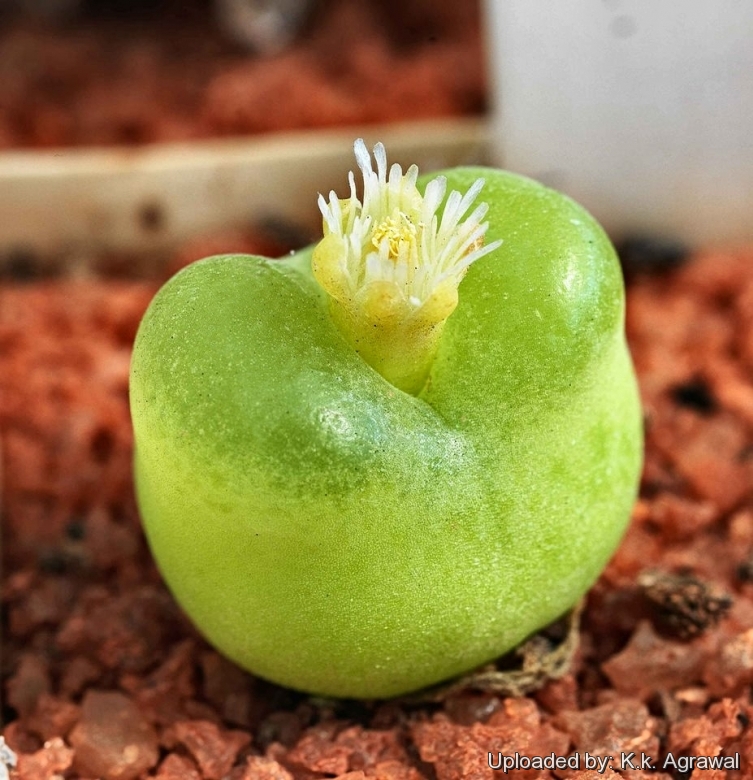Accepted Scientific Name: Conophytum maughanii subs. latum (Tischer) S.A.Hammer
Gen. Conophytum 249 1993 S.A.Hammer

Ophthalmophyllum latum (Conophytum maughanii subs. latum) Photo by: K.k. Agrawal
Origin and Habitat: Conophytum maughaniiSN|22606]]SN|22606]] subsp. latum is endemic to the Namaqualand, Northern Cape (South-eastern Richtersveld between Eksteenfontein and Umdaus), in the Republic of South Africa (Extent of occurrence 681 km²). It is widespread with scattered individuals, and sometimes locally common.
Habitat and Ecology: This species grows on quartz flats in the Succulent Karoo in various types of succulent shrubland. There are no severe threats to the taxon, although some small subpopulations may be damaged by road tracks and localised mineral exploration diggings. It is however unlikely to be causing a significant overall decline to the population.
Synonyms:
See all synonyms of Conophytum maughanii
Description: Conophytum maughaniiSN|22606]]SN|22606]] subs. latum, is a distinctive subspecies of Conophytum maughaniiSN|22606]]SN|22606]] with convex, windowed bodies. Its bodies occur singly or in pairs and are cylindrical to conical, up to 25 mm tall, yellowish-green to brilliant red, and slightly papillous, and the flowers are smaller, nocturnal and very strongly scented.
Derivation of specific name: This subspecies has been named for its proportions; the bodies are often broader than tall. Dried sheath pale brownish-yellow, marked with scattered tannins (dots), very thin.
Body (paired leaves): Single, in pairs or very sparsely branched, sunken, 8-15(-20) mm long, 15-20(-25) mm wide, 10-15(-20) mm thick, depressed- globose to turbiniform (conical) with a small central depression. The apex is often smaller than the base. The end surfaces of the lobes are somewhat truncate to slightly convex, translucent (windowed) or nearly opaque. The epidermis is glabrous, pale yellowish-green to beet-red or ochre, marked with greenish idioblasts (water storage cells and tannin cells), often opalescent near the fissure. The fissure is short, sunken, glabrous.
Flowers: Small, nocturnal, milk-white to pale yellowish or peach-pink very strongly scented. Bracts short, hidden in the body. Calyx- short, green or pinkish-green, with 5-7 greenish sepals 2-3 mm long. Petals ca. 50-70 in 3-5 series white to yellow or pink, usually short (ca. 10 x 2mm), spathulate, innermost ones very thin. Stamens many, reaching or exceeding the mouth of the tube, anthers pale yellow; stigmas 5-7, free.
Fruit (capsule): 7-locular, 2 mm long, 5 mm wide, quite soft, depressed obovate, pale brown, sparsely dotted.
Seeds: 0.45 long, 0.35 wide, 0.30 mm thick, densely papillate.
Blooming season: Mid-autumn.
Subspecies, varieties, forms and cultivars of plants belonging to the Conophytum maughanii group
Notes: Most plants turn an intense saturated red in late winter as dormancy approaches, but in many populations some plants are always red; these match Tischer's Ophthalmophyllum latumSN|22613]]SN|22613]] var. rubrum which hence does not justify the separation as a variety (Hartmann 2012).
Bibliography: Major references and further lectures
1) Heidrun E.K. Hartmann "Illustrated Handbook of Succulent Plants: Aizoaceae A-E" Springer Science & Business Media, 06 December 2012
2) Steven A. Hammer, "The genus Conophytum: a conograph", Succulent Plant Publications, 1993
3) Werner Rauh, "The Wonderful World of Succulents: Cultivation and Description of Selected Succulent Plants Other Than Cacti", Smithsonian Institution Press, 1984
4) Hall, A.V., De Winter, M., De Winter, B. and Van Oosterhout, S.A.M. 1980. "Threatened plants of southern Africa". South African National Scienctific Programmes Report 45. CSIR, Pretoria.
5) Hammer, S. 2002. "Dumpling and his wife: New view of the genus Conophytum". EAE Creative Colour, Norwich.
6) Hilton-Taylor, C. 1996. "Red data list of southern African plants". Strelitzia 4. South African National Botanical Institute, Pretoria.
7) Raimondo, D., von Staden, L., Foden, W., Victor, J.E., Helme, N.A., Turner, R.C., Kamundi, D.A. and Manyama, P.A. 2009. "Red List of South African Plants". Strelitzia 25. South African National Biodiversity Institute, Pretoria.
8) Young, A.J. 2015. Conophytum maughanii N.E.Br. subsp. latum (Tischer) S.A.Hammer. National Assessment: Red List of South African Plants version 2017.1. Accessed on 2017/12/03
Cultivation and Propagation: They are relatively difficult to grow. These plants grow on winter rain and head for summer dormancy. The growing season in northern hemisphere is from September to March. During this period they present their red flowers and can be lightly watered about once a week or (better) misted every day and will become plump. In Africa, the mist from morning fog provides moisture. Otherwise their epidermis breaks (resulting in unsightly scars). Water minimally in summer, (only occasional misting). Start watering again in autum after the previous year's leaves have dried up. Require good drainage. They enjoy full sun or half-shade and in summer they need to be kept in a cool area. Hardy to -2°C. Ensure a very good ventilation. Avoid to repot frequently. They may stay in the same pot for many years. Plants grown in larger containers have frequently relatively poor flowers. They might improve when the plants are given their own, small individual pots.
Propagation: They can be reproduced by seeds.










